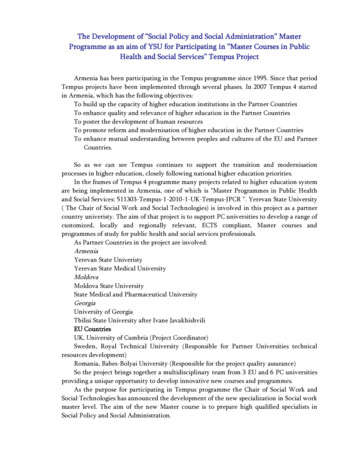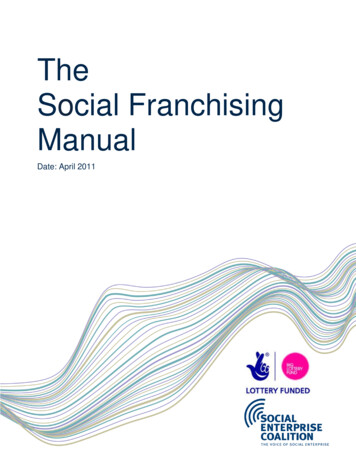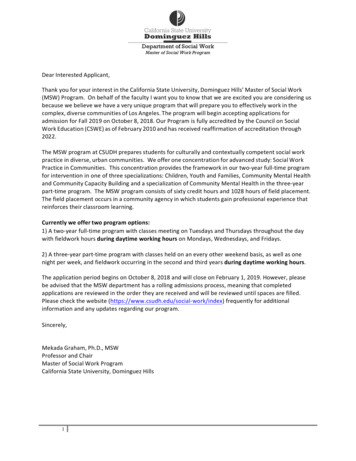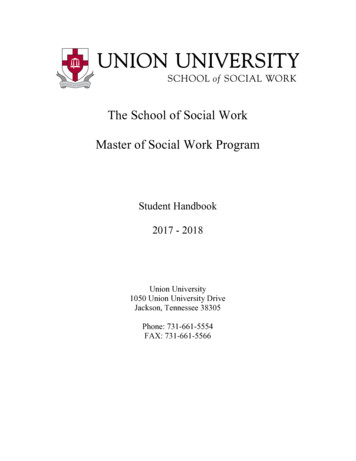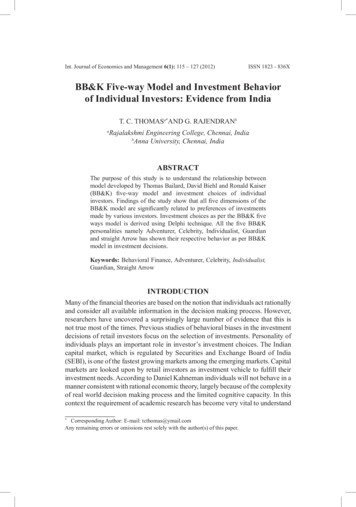
Transcription
SOCIAL STYLEand The FiveDysfunctionsof a Team S O C I A LS T Y L EC O N N E C T I O N S
O V E R V IEW“The Five Dysfunctions of a Team” by Patrick Lencioni outlines five common pitfalls that preventteams from achieving their full capabilities. And given the widespread use of teams in the businessworld, these dysfunctions have significant impact on overall organizational performance. Thiswhitepaper looks at how the behavioral preferences and emotional intelligence (EQ) components ofTRACOM’s SOCIAL STYLE Model relate to the “Five Dysfunctions” concepts.SOCIAL STYLE CONNECTIONSSOCIAL STYLE is the world’s most effective interpersonal skills model. The Connections WhitepaperSeries looks at how SOCIAL STYLE complements and supports other popular workplace programsincluding Situational Leadership, Emotional Intelligence, Crucial Conversations and The FiveDysfunctions of a Team.The TRACOM Group has no affiliation with “The Five Dysfunctions of a Team”, or the book’s author;Patrick Lencioni. Neither the book’s publishers, authors nor other representatives have reviewed orapproved this paper.SOCIAL STYLE AND THE FIVE DYSFUNCTIONS OF A TEAM2
I N TR O D UCT IONMuch of the work performed in organizations today is done by teams. It’s hard to imagine notcontributing to at least one team on any given day. Teams are critical to every organization’s success;they determine and set strategies, generate ideas for new products, and solve problems. Given theirimportance, why do so many people complain about their teams? If you ask Patrick Lencioni, it isbecause most teams are dysfunctional.In his book, “The Five Dysfunctions of a Teami,” Lencioni outlines five common pitfalls that preventteams from achieving their full capabilities. Underlying each of these five dysfunctions is the failureto have an in-depth understanding of one another’s Style. According to Lencioni, “some of the mosteffective and lasting tools for building trust on a team are profiles of team members’ behavioralpreferences and personality styles. These help break down barriers by allowing people to betterunderstand and empathize with one another” (p. 199).The SOCIAL STYLE Model provides an ideal platform that serves as a starting point for solvingthe Five Dysfunctions. SOCIAL STYLE and the application of behavioral Versatility offers a highlyusable model of people’s behavioral preferences, strengths and weaknesses. It provides individualsfeedback on interpersonal skills and realistic advice on how to contribute to teams. It leads togreater interpersonal awareness, understanding and more productive teams.SOCIAL STYLE AND THE FIVE DYSFUNCTIONS OF A TEAM3
O V E R V I EW OF T H E F IVEDYS F U NCT IONS OF A TE AM MO DE LAccording to Lencioni, most teamsunknowingly fall victim to fiveinterrelated dysfunctions. Teams whosuffer from even one of the five aresusceptible to the other four. Solvingall five is required to create a highfunctioning team. The five dysfunctionsare displayed in a pyramid to the right.Dysfunction One – Absence of TrustWhen team members do not trustone another, they are unwilling tobe vulnerable within the team. Itis impossible for a team to builda foundation for trust when teammembers are not genuinely open abouttheir mistakes and weaknesses.INATTENTIONTO RESULTSAVOIDANCE OFACCOUNTABILITYLACK OFCOMMITMENTFEAR OF CONFLICTABSENCE OF TRUSTDysfunction Two – Fear of ConflictFailure to build trust sets the stage for the second dysfunction. Teams without trust are unable to engage inpassionate debate about ideas. Instead, they are guarded in their comments and resort to discussions thatmask their true feelings.Dysfunction Three – Lack of Commitment Teams that do not engage in healthy conflict will suffer fromthe third dysfunction. Because they do not openly surface their true opinions or engage in open debate,team members will rarely commit to team decisions, though they may feign agreement in order to avoidcontroversy or conflict.Dysfunction Four – Avoidance of Accountability A lack of commitment creates an atmosphere where teammembers do not hold one another accountable. Because there is no commitment to a clear action plan,team members hesitate to hold one another accountable on actions and behaviors that are contrary to thegood of the team.Dysfunction Five – Inattention to Results The lack of accountability makes it possible for people to puttheir own needs above the team’s goals. Team members will focus on their own career goals or recognitionfor their departments to the detriment of the team. A weakness in any one area can cause teamwork todeteriorate. The model is easy to understand, and yet can be difficult to practice because it requires highlevels of discipline and persistence.SOCIAL STYLE AND THE FIVE DYSFUNCTIONS OF A TEAM4
H O W S OCIA L S T YL E ANDV E R SA T IL IT Y ENH A NCE TE AMWO R KSOCIAL STYLE and Versatility provide a proven and easy-to-use strategy for team members to understandthemselves and one another, and to overcome the five dysfunctions. The Model provides an awareness ofhow people behave towards others, use their time, and make decisions. Further, the Versatility componentof the Model provides advice for increasing interpersonal effectiveness with individuals regardless of theirparticular Styles. Research has shown that SOCIAL STYLE is easier to learn and apply than either DiSC orMyers-Briggs. Of additional importance, the SOCIAL STYLE Profile is available as a multi-rater instrument,providing feedback from other team members, which helps to overcome the biased and inaccurateperceptions people often have of themselves.In the following sections we describe how Style and Versatility help to manage the five team dysfunctions.WORKING TOGETHER WITHSOCIAL STYLEAwareness of SOCIAL STYLE is particularlyimportant for the first two dysfunctions:absence of trust and fear of conflict.Understanding one another’s Styles helpsteams develop trust and learn to debate inhealthy and productive ways. This providesa solid basis for managing the other threedysfunctions, where Versatility plays animportant role. Versatility provides tools andmechanisms for team members to reachcommitment, hold one another accountable,and achieve results.SOCIAL STYLEFEAR OF CONFLICTABSENCE OF TRUSTAbsence of TrustLencioni states that trust lies at the heart of a functioning, cohesive team, and that without trust teamworkis all but impossible. Members of trusting teams admit weaknesses, take risks by offering one anotherfeedback and assistance, focus their energy on important issues, and are willing to ask for help. Teams thatuse a focused approach can achieve trust, and one of the best ways to do this is to utilize a behavioral stylesprofile.The SOCIAL STYLE Model focuses on people’s behavior – the things they do and say to one another. Itprovides a very clear description of people’s strengths and weaknesses, as well as insight into people’s workpreferences. This knowledge is invaluable for creating an atmosphere of trust.Different Styles of people often have a hard time working together, and this can lead to a breakdown oftrust. This is particularly true for people who have opposite Styles because their behavioral preferences aredramatically different from one another. For example, during team meetings an Expressive person speaksloudly, frequently, and likes to make decisions quickly. In contrast, an Analytical person speaks softly, lessSOCIAL STYLE AND THE FIVE DYSFUNCTIONS OF A TEAM5
frequently, and wants to take time before coming to decisions. Because these people’s Styles are at odds,their behavioral differences can lead to conflict and a lack of trust. SOCIAL STYLE can help. By recognizingStyle differences, these individuals will develop a better understanding and acceptance of one another.They will identify one another’s strengths and weaknesses, and how to accept and capitalize on them.Since their differences are merely behavioral and are not a reflection of personal judgments or personalitydisputes, they will more easily develop a cohesive and trusting team that focuses on work rather than Styledifferences.Fear of ConflictTeam members sometimes engage in heated and unhealthy conflict that undermines effective teamwork.Instead, it becomes very personal and results in damaged relationships and an atmosphere whereproductive debate is virtually nonexistent. The SOCIAL STYLE Model helps in two specific ways. First, itdescribes each Style’s “Backup Behavior” when under stress and how people engage in conflict. Second, theModel explains how to manage this behavior and replace it with effective communication strategies.Returning to our example, the Backup Behavior for Expressive Style people is to attack. They areconfrontational and verbally aggressive. In contrast, Analytical Style people’s Backup Behavior is towithdraw; they try to avoid the situation. Conflict between these two people will lead to a situation wherehealthy debate is rare. The Expressive Style person will display outright hostility while the AnalyticalStyle person will go out of his way to avoid saying anything that might trigger this type of outburst. Bothapproaches lead to a poisonous atmosphere without meaningful discussion of ideas. However, simplylearning about these Style differences helps to neutralize them. This is because the SOCIAL STYLE Modelprovides techniques for engaging with one another in ways that focus on ideas rather than personalitiesand behavioral differences. This will lead to more effective conflict, where team members solve problemswithout wasting time on politics and personaldifferences.VERSATILITYVERSATILITY AND TEAMWORKSOCIAL STYLE can help teams trust oneanother and engage in productive debate.With Style as a foundation, Versatility isessential for dealing with the next threedysfunctions – lack of commitment,avoidance of accountability, and inattentionto results. Lencioni provides team-buildingand problem- solving techniques to managethese pitfalls. While these tools are helpful,individual team members’ Versatility is criticalfor overcoming these dysfunctions.LACK OFCOMMITMENTLack of CommitmentAccording to Lencioni, commitment is a function of clarity and buy-in. Effective teams make timely and cleardecisions with buy-in from all team members, even those who do not agree with the decision. Teams withSOCIAL STYLE AND THE FIVE DYSFUNCTIONS OF A TEAM6
Appropriate Use ofIMAGE Dress and GroomingPRESENTATION Effectiveness of GroupCommunicationCOMPETENCEFEEDBACK Conscientiousness Active Listening Flexibility Adaptive Communication Innovation Empathy Perseverance Interpersonal Relations Optimismcommitment have common objectives, move forward without hesitation, change direction when necessary,and learn from their mistakes.To reach commitment, the Five Dysfunctions model recommends techniques such as establishing cleardeadlines and communicating the team’s goals throughout the organization. This happens through effectivediscussion, which is a reflection of Feedback. Feedback involves active listening and understanding otherteam members’ concerns and viewpoints. It also includes adapting communication to match the Styles ofother team members. When team members practice Feedback, it helps create an atmosphere where teamscan reach commitment. Competence is also important for achieving commitment. Team members need tobe flexible to changing circumstances and make decisions when information is ambiguous or imperfect. AsLencioni makes clear, effective teams move forward without getting stuck in “analysis paralysis.”Avoidance of AccountabilityAccountability requires team members to call their peers on performance or behaviors that might hurt theteam. Teams that hold one another accountable identify problems quickly by questioning one another’sactions, hold one another to the same standards, and avoid needless bureaucracy around managingperformance.Lencioni states that making the team’s goals public and conducting regular progress reviews are techniquesthat can contribute to individual accountability. However, personal Competence is especially important.Individuals need to take responsibility to meet their obligations and persevere to achieve their goals.Optimism is also important. An optimistic outlook is critical since it communicates confidence to other teammembers and to the rest of the organization that the team is on the right track. An optimistic team is morelikely to hold one another accountable for achieving its goals.Inattention to ResultsThe ultimate dysfunction is when members put their own status or personal goals above the best interestsof the team. Teams that focus on results minimize this type of self-centered behavior. Publicly declaringthe team’s results and offering results-based rewards are techniques for managing this dysfunction.Once again, many of the same Versatility skills we’ve been discussing are relevant here. Without personalconscientiousness, perseverance, flexibility, and optimism, it would be difficult if not impossible for teamsSOCIAL STYLE AND THE FIVE DYSFUNCTIONS OF A TEAM7
B E N E F I T S & S UMMA RYThe Five Dysfunctions of a Team model provides a persuasive analysis of the common pitfalls ofmany teams, as well as effective strategies for overcoming these hazards. An understanding of oneanother’s strengths, weaknesses, and Style preferences is the heart of effective teamwork. It is thefoundation for teamwork, and it is best achieved through the insights and tools learned from SOCIALSTYLE. In this whitepaper we have described how SOCIAL STYLE provides a basis for implementingLencioni’s teamwork model, and how Versatility builds on Style awareness to further enhanceindividual and team performance.REFERENCESWe are grateful to Dr. Karl Krumm for his review and comments on this whitepaper.The TRACOM Group has no affiliation with “The Five Dysfunctions of a Team”, or the book’s author; Patrick Lencioni. Neither the book’spublishers, authors nor other representatives have reviewed or approved this paper.SOCIAL STYLE AND THE FIVE DYSFUNCTIONS OF A TEAM8
ABOUT[WHY we do]We believe that improving peoples’ understanding ofthemselves and others makes the world a better place.[WHAT we do]We synthesize our discoveries into actionable learning andresources that improve an individual’s performance in allparts of their lives. We call this Social Intelligence.[HOW we do it]Through research and experience we uncover the hiddenbarriers to individuals achieving their maximum potentialand identify how to help overcome them.For more information, visit WWW.TRACOMCORP.COMor call (303) 470-4900 — (800) 221-2321 (U.S. only)
“The Five Dysfunctions of a Team” by Patrick Lencioni outlines five common pitfalls that prevent teams from achieving their full capabilities. And given the widespread use of teams in the business world, these dysfunctions have signi


